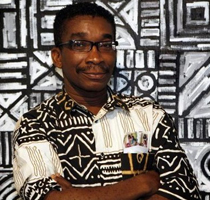First, what Enwezor’s strategy seeks to do, unfortunately, is to eclipse the professional careers of numerous African artists who live on the continent and work in dire circumstances to contribute their humble quota to the advancement of the continent. They are literally banned from joining the global post-modernist discourse, and their work is easily dismissed as moribund. Many of these artists struggle to eke out a bare living from inadequate and poor sales of their work. In fact, the works of African artists living and working in Africa, apart from El Anatsui and, probably, one or two others, sell for a pittance, whilst that of their colleagues abroad, because of their constant exposure, visibility, circulation and discursiveness, have a much greater market and cultural value, catapulting their prices into stratospheric realms. They are often represented in auction houses in Europe and America, too. Have Okwui Enwezor and his disciples ever wondered why there is such astronomical and incongruous disparity in the value placed on the works of African artists in the West and those based on the continent? This is a serious anomaly and does not have to be countenanced one-bit.
Secondly, African countries are battling with having to stem the tide of the brain-drain. The young, budding artist only sees African artists living in the West as successful and regarded with reverence and esteem more so than their counterparts in Africa. This young, ambitious artist obviously, desiring a glint of the limelight, would not see any future of himself in Africa. He will pack bag-and-baggage and head to the West, depleting the continent further of its human resource.
Thirdly, other African art forms that are contemporaneous to all the current development of art in the West in this post-modern era, where your difference is wholly acceptable in the global dialogue, have been relegated to the background or pushed to the margin because they do not fall into the parochial definitions of post-modernist art for these African curators.
With the advent of Post-modernism, the hierarchical authority which Modern Art once had and enjoyed, the high-brow elitism, have all been dismantled; art from high and low cultures now co-exist in the same discursive space; Modern Art which was the cultural appendage the Colonizer used to differentiate itself from the Colonized, had become moribund and was no longer in currency; the dichotomy of the center and the periphery no longer exists. The world has become flat! And buttressed by ICT (Information Communication Technology), there is equal opportunity for everybody.
Postmodernism, therefore, does not mean sublimating your own culture to appear at the global dinner table without any culture of your own. Far from it. There is, indeed, African culture, contrary to what Okwui Enwezor has been postulating. Our difference as Africans is wholly acceptable to the postmodernist dialogue. In fact, the global universalizing cultural machine is gullible for all the cultures of the world. We do not have to clone ourselves as Euro-Americans to be welcomed to the global discourse on art today. But that is exactly what Okwui Enwezor has done with contemporary African art.
Given the opportunity to introduce contemporary African art into the global discourse, if Okwui Enwezor had, for instance, presented the native Sirigu (Ghana) wall painters as Africa’s contemporary artistic expression, of course, with a discourse accompanying it, I overly believe the art world would have embraced and welcomed it into the global universalizi0ng table, coalescing it with other artistic expressions from elsewhere to become one universal culture. But for easy accessibility, Enwezor who was living in the West at that time (and still does), preferred settling on Western-based African artists, many of whom, in order to become acceptable in the West, which was largely unreceptive to their work, had tailored their works to look like work by Western artists, mainly a preponderance of installation work and new-media, that is, technology art, video and photography. This was a golden opportunity lost for Okwui Enwezor in presenting African contemporary art as it truly was, as authentically reflected from the ground. So he defensively had to get into all those bizarre definitions of authenticity when it comes to cultural production, who the African was and what African culture represented vis-a-vis global culture, to validate the work of artists in the Diaspora.
Okwui Enwezor should not delude himself into thinking that he has brought contemporary African art to a universalizing culture. With his renunciation of all that is traditionally African, what Enwezor has rather done is easily succumbing to the Western hegemonic dominance of art. So instead of a true global culture which gives cognizance to various cultures in its grafting and blending processes to achieve a true universal mono-culture, what we have today is still the Western-dominated art. Okwui Enwezor has sold Africa short! So, from one art fair to the other, from São Paolo to Basel, from Istanbul to Cairo, it is still the same art we see, a proliferation of installation and new media. The Western metropolises of London, New York, Paris, Barcelona and Berlin are still the major centers of world art, where all the decisions on global art are taken. The African continent is still marginalized when it comes to World Art.
Reviewing africa’95 in Glendora – African Quarterly of the Arts in a self-revelatory, trenchant article captioned, Occupied Territories: Power, Access & African Art, what Enwezor said of Jean Pigozzi and his collection can be said of Okwui Enwezor himself today:
Pigozzi’s imprimatur…effectively plays on the access provided by (his money and) powerful connections. He has used them in an accelerated campaign through alliances with major institutions, publishers and write-ups in important publications to legitimize and valorize many questionable artists (in his collection), pushing them to the world as the only ‘authentic’ artists from Africa. This way debate and criticism is silenced, foreclosed, or pushed to the periphery. While a sunny carnivalesque, celebratory and (ethnographic) [postmodernist – my own word] discourse is woven around the various appropriate artists (in his collection), major institutions, in clear violation of their own policies towards other forms of representation, unnecessarily tow the party-line, allying themselves with what is basically a con game.





No Comments so far ↓
There are no comments yet...Kick things off by filling out the form below.